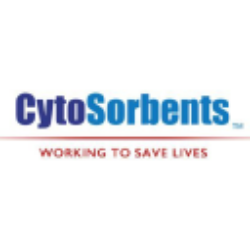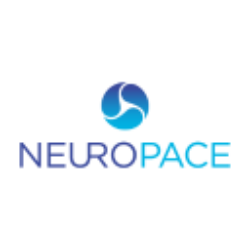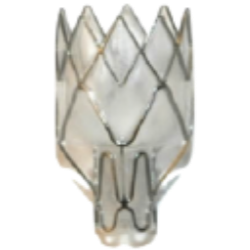CTSO

Cytosorbents Corporation
CTSO
(0.8)1,14 USD
-47.78% ROA
-13069.04% ROE
-2.4x PER
61.505.448,00 USD
84.16% DER
0% Yield
-27.2% NPM
Cytosorbents Corporation Stock Analysis
Cytosorbents Corporation Fundamental Analysis
Fundamental analysis in stock investing is like studying the foundation of a house before buying it. It involves looking at a company's financial health, like its earnings, assets, and debts, to determine if it's a good investment based on its fundamental strength and potential for growth.
| # | Analysis | Rating |
|---|---|---|
| 1 |
PBV
The stock's PBV ratio (2.08x) reflects a fair valuation, making it an attractive option for investors seeking balanced opportunities. |
|
| 2 |
DER
The stock has a reasonable amount of debt compared to its ownership (75%), suggesting a balanced financial position and a moderate level of risk. |
|
| 3 |
Graham Number
The Graham number calculation reveals that this company's stock price is potentially underestimated, implying that it may be a promising investment option. |
|
| 4 |
ROE
The stock's ROE indicates a negative return (-81%) on shareholders' equity, suggesting poor financial performance. |
|
| 5 |
ROA
The stock's ROA (-49.26%) indicates that it's not effectively utilizing its assets to generate profits, making it a less favorable option to invest and earn consistent returns. |
|
| 6 |
Revenue Growth
Company's revenue has stayed stagnant, showing no signs of improvement and making it a less favorable choice. |
|
| 7 |
Net Profit Growth
Throughout the last five years, this company's net profit has remained unchanged, indicating a lack of growth and making it a less favorable investment option. |
|
| 8 |
Assets Growth
Company's revenue has stayed stagnant, showing no signs of improvement and making it a less favorable choice. |
|
| 9 |
Dividend Growth
The company's dividend growth has shown no improvement in the past three years, making it a less attractive investment option for those seeking increasing returns. |
|
| 10 |
Dividend
Investors should note the absence of dividends from the company in the last three years, indicating potential financial challenges. |
|
| 11 |
Buffet Intrinsic Value
The company's stock presents a potential concern as it appears overvalued (-2) by Warren Buffett's formula, indicating that its market price exceeds its estimated intrinsic value. |
Cytosorbents Corporation Technical Analysis
Technical analysis in stock investing is like reading the patterns on a weather map to predict future weather conditions. It involves studying past stock price movements and trading volumes to make predictions about where a stock's price might go next, without necessarily looking at the company's financial health.
| # | Analysis | Recommendation |
|---|---|---|
| 1 | Awesome Oscillator | Hold |
| 2 | MACD | Buy |
| 3 | RSI | Hold |
| 4 | Stoch RSI | Sell |
Cytosorbents Corporation Price Chart
Financial Statements
Financial statements are like report cards for companies. They show how much money a company makes (income statement), what it owns and owes (balance sheet), and where it spends its money (cash flow statement), helping stock investors understand if a company is healthy and worth investing in.
Income Statements
An income statement for a company is like a scoreboard for its profits and losses. It shows how much money the company made (revenue) and how much it spent to make that money (expenses), helping stock investors see if a company is making a profit or not.
Revenue in stock investing is the total amount of money a company earns from its sales, and it's a key factor that investors consider to assess a company's financial performance and growth potential.
| Year | Revenue | Growth |
|---|---|---|
| 2005 | 10.000 | |
| 2006 | 0 | 0% |
| 2007 | 0 | 0% |
| 2008 | 0 | 0% |
| 2009 | 0 | 0% |
| 2010 | 0 | 0% |
| 2011 | 36.078 | 100% |
| 2012 | 151.574 | 76.2% |
| 2013 | 821.787 | 81.56% |
| 2014 | 3.145.000 | 73.87% |
| 2015 | 4.055.753 | 22.46% |
| 2016 | 8.206.036 | 50.58% |
| 2017 | 13.381.853 | 38.68% |
| 2018 | 20.252.383 | 33.92% |
| 2019 | 22.766.000 | 11.04% |
| 2020 | 39.453.000 | 42.3% |
| 2021 | 40.109.000 | 1.64% |
| 2022 | 29.360.000 | -36.61% |
| 2023 | 31.016.000 | 5.34% |
| 2023 | 36.349.379 | 14.67% |
| 2024 | 39.578.544 | 8.16% |
Research and Development Expenses are the costs a company incurs to create and improve its products or services, which can be important for investors to evaluate a company's innovation and potential for future growth.
| Year | Research and Development Expenses | Growth |
|---|---|---|
| 2005 | 0 | |
| 2006 | 1.112.804 | 100% |
| 2007 | 1.415.509 | 21.38% |
| 2008 | 1.983.483 | 28.64% |
| 2009 | 1.961.960 | -1.1% |
| 2010 | 1.757.370 | -11.64% |
| 2011 | 2.888.245 | 39.15% |
| 2012 | 2.532.489 | -14.05% |
| 2013 | 1.738.938 | -45.63% |
| 2014 | 2.432.000 | 28.5% |
| 2015 | 3.871.069 | 37.17% |
| 2016 | 4.783.491 | 19.07% |
| 2017 | 4.049.436 | -18.13% |
| 2018 | 7.723.028 | 47.57% |
| 2019 | 12.092.000 | 36.13% |
| 2020 | 8.810.000 | -37.25% |
| 2021 | 16.381.000 | 46.22% |
| 2022 | 15.119.000 | -8.35% |
| 2023 | 14.996.000 | -0.82% |
| 2023 | 15.728.915 | 4.66% |
| 2024 | 6.078.472 | -158.76% |
General and Administrative Expenses are the costs a company incurs to run its day-to-day operations, such as office rent, salaries, and utilities, which investors consider to understand a company's overall efficiency and management effectiveness.
| Year | General and Administrative Expenses | Growth |
|---|---|---|
| 2005 | 70.000 | |
| 2006 | 939.128 | 92.55% |
| 2007 | 1.651.121 | 43.12% |
| 2008 | 909.372 | -81.57% |
| 2009 | 757.450 | -20.06% |
| 2010 | 1.066.649 | 28.99% |
| 2011 | 1.572.840 | 32.18% |
| 2012 | 1.981.983 | 20.64% |
| 2013 | 3.485.395 | 43.13% |
| 2014 | 6.836.000 | 49.01% |
| 2015 | 8.011.660 | 14.67% |
| 2016 | 12.282.752 | 34.77% |
| 2017 | 15.425.556 | 20.37% |
| 2018 | 22.876.408 | 32.57% |
| 2019 | 24.468.000 | 6.5% |
| 2020 | 31.512.000 | 22.35% |
| 2021 | 38.482.000 | 18.11% |
| 2022 | 37.136.000 | -3.62% |
| 2023 | 36.832.000 | -0.83% |
| 2023 | 37.872.361 | 2.75% |
| 2024 | 33.607.732 | -12.69% |
EBITDA stands for Earnings Before Interest, Taxes, Depreciation, and Amortization. It is a measure that helps stock investors analyze a company's profitability by looking at its earnings without considering certain expenses. This helps to get a clearer picture of the company's financial performance and its ability to generate cash flow.
| Year | EBITDA | Growth |
|---|---|---|
| 2005 | -70.000 | |
| 2006 | -1.740.393 | 95.98% |
| 2007 | -3.160.314 | 44.93% |
| 2008 | -3.140.511 | -0.63% |
| 2009 | -2.975.667 | -5.54% |
| 2010 | -2.805.300 | -6.07% |
| 2011 | -4.396.153 | 36.19% |
| 2012 | -3.436.228 | -27.94% |
| 2013 | -4.648.881 | 26.08% |
| 2014 | -6.827.289 | 31.91% |
| 2015 | -9.190.690 | 25.72% |
| 2016 | -11.864.010 | 22.53% |
| 2017 | -8.170.187 | -45.21% |
| 2018 | -15.979.127 | 48.87% |
| 2019 | -18.742.892 | 14.75% |
| 2020 | -9.709.546 | -93.04% |
| 2021 | -22.013.167 | 55.89% |
| 2022 | -30.003.258 | 26.63% |
| 2023 | -29.400.000 | -2.05% |
| 2023 | -28.810.817 | -2.05% |
| 2024 | -11.149.240 | -158.41% |
Gross profit is the money a company makes from selling its products or services after subtracting the cost of producing or providing them, and it is an important measure for investors to understand a company's profitability.
| Year | Gross Profit | Growth |
|---|---|---|
| 2005 | 0 | |
| 2006 | 0 | 0% |
| 2007 | 0 | 0% |
| 2008 | 0 | 0% |
| 2009 | 0 | 0% |
| 2010 | 0 | 0% |
| 2011 | 24.318 | 100% |
| 2012 | -167.724 | 114.5% |
| 2013 | -1.089.778 | 84.61% |
| 2014 | 1.011.000 | 207.79% |
| 2015 | 1.843.207 | 45.15% |
| 2016 | 4.252.311 | 56.65% |
| 2017 | 7.863.493 | 45.92% |
| 2018 | 12.762.983 | 38.39% |
| 2019 | 15.402.000 | 17.13% |
| 2020 | 28.400.000 | 45.77% |
| 2021 | 29.061.000 | 2.27% |
| 2022 | 15.404.000 | -88.66% |
| 2023 | 18.200.000 | 15.36% |
| 2023 | 22.392.023 | 18.72% |
| 2024 | 26.010.916 | 13.91% |
Net income in stock investing is like the money a company actually gets to keep as profit after paying all its bills, and it's an important measure to understand how well a company is doing financially.
| Year | Net Profit | Growth |
|---|---|---|
| 2005 | -80.000 | |
| 2006 | -7.671.580 | 98.96% |
| 2007 | -3.350.754 | -128.95% |
| 2008 | -3.017.890 | -11.03% |
| 2009 | -2.736.715 | -10.27% |
| 2010 | -2.908.865 | 5.92% |
| 2011 | -5.481.648 | 46.93% |
| 2012 | -3.663.506 | -49.63% |
| 2013 | -4.677.795 | 21.68% |
| 2014 | -9.321.000 | 49.81% |
| 2015 | -8.131.738 | -14.62% |
| 2016 | -11.938.875 | 31.89% |
| 2017 | -8.460.799 | -41.11% |
| 2018 | -17.211.179 | 50.84% |
| 2019 | -19.266.000 | 10.67% |
| 2020 | -7.837.000 | -145.83% |
| 2021 | -24.559.000 | 68.09% |
| 2022 | -32.813.000 | 25.15% |
| 2023 | -36.772.000 | 10.77% |
| 2023 | -28.507.394 | -28.99% |
| 2024 | -16.572.584 | -72.02% |
EPS, or earnings per share, is a measure that shows how much profit a company has earned for each outstanding share of its stock, and it is important for stock investors as it helps understand the profitability of a company and compare it with other companies in the market.
| Year | Earning per Share (EPS) | Growth |
|---|---|---|
| 2005 | 0 | |
| 2006 | -13 | 100% |
| 2007 | -3 | -300% |
| 2008 | -3 | 0% |
| 2009 | -2 | -200% |
| 2010 | -1 | 0% |
| 2011 | -1 | 0% |
| 2012 | 0 | 0% |
| 2013 | -1 | 0% |
| 2014 | -1 | 0% |
| 2015 | 0 | 0% |
| 2016 | 0 | 0% |
| 2017 | 0 | 0% |
| 2018 | -1 | 0% |
| 2019 | -1 | 0% |
| 2020 | 0 | 0% |
| 2021 | -1 | 0% |
| 2022 | -1 | 0% |
| 2023 | -1 | 0% |
| 2023 | -1 | 0% |
| 2024 | 0 | 0% |
Cashflow Statements
Cashflow statements show the movement of money in and out of a company, helping stock investors understand how much money a company makes and spends. By examining cashflow statements, investors can assess if a company is generating enough cash to pay its bills, invest in growth, and provide returns to stockholders.
Free cash flow is the leftover cash that a company generates after covering its operating expenses and capital expenditures, which is important for stock investors as it shows how much money a company has available to invest in growth, pay dividends, or reduce debt.
| Year | Free Cashflow | Growth |
|---|---|---|
| 2005 | -50.000 | |
| 2006 | -2.914.045 | 98.28% |
| 2007 | -2.661.525 | -9.49% |
| 2008 | -2.387.401 | -11.48% |
| 2009 | -2.688.941 | 11.21% |
| 2010 | -2.642.707 | -1.75% |
| 2011 | -3.881.017 | 31.91% |
| 2012 | -3.655.253 | -6.18% |
| 2013 | -3.705.676 | 1.36% |
| 2014 | -7.028.515 | 47.28% |
| 2015 | -9.652.381 | 27.18% |
| 2016 | -7.326.498 | -31.75% |
| 2017 | -8.138.824 | 9.98% |
| 2018 | -12.359.948 | 34.15% |
| 2019 | -18.278.899 | 32.38% |
| 2020 | -7.289.504 | -150.76% |
| 2021 | -18.286.860 | 60.14% |
| 2022 | -34.689.858 | 47.28% |
| 2023 | -5.463.943 | -534.89% |
| 2023 | -22.591.372 | 75.81% |
| 2024 | -4.914.518 | -359.69% |
Operating cash flow represents the cash generated or consumed by a company's day-to-day operations, excluding external investing or financing activities, and is crucial for stock investors as it shows how much cash a company is generating from its core business operations.
| Year | Operating Cashflow | Growth |
|---|---|---|
| 2005 | -50.000 | |
| 2006 | -2.849.182 | 98.25% |
| 2007 | -2.627.839 | -8.42% |
| 2008 | -2.365.349 | -11.1% |
| 2009 | -2.674.613 | 11.56% |
| 2010 | -2.477.258 | -7.97% |
| 2011 | -3.828.527 | 35.29% |
| 2012 | -3.616.447 | -5.86% |
| 2013 | -3.489.320 | -3.64% |
| 2014 | -6.661.193 | 47.62% |
| 2015 | -9.008.934 | 26.06% |
| 2016 | -6.730.967 | -33.84% |
| 2017 | -6.460.705 | -4.18% |
| 2018 | -10.839.684 | 40.4% |
| 2019 | -16.758.782 | 35.32% |
| 2020 | -5.613.286 | -198.56% |
| 2021 | -14.005.599 | 59.92% |
| 2022 | -28.234.282 | 50.4% |
| 2023 | -5.206.228 | -442.32% |
| 2023 | -21.655.136 | 75.96% |
| 2024 | -4.794.653 | -351.65% |
Capex, short for capital expenditures, refers to the money a company spends on acquiring or upgrading tangible assets like buildings, equipment, or technology, which is important for stock investors as it indicates how much a company is investing in its infrastructure to support future growth and profitability.
| Year | Capital Expenditure | Growth |
|---|---|---|
| 2005 | 0 | |
| 2006 | 64.863 | 100% |
| 2007 | 33.686 | -92.55% |
| 2008 | 22.052 | -52.76% |
| 2009 | 14.328 | -53.91% |
| 2010 | 165.449 | 91.34% |
| 2011 | 52.490 | -215.2% |
| 2012 | 38.806 | -35.26% |
| 2013 | 216.356 | 82.06% |
| 2014 | 367.322 | 41.1% |
| 2015 | 643.447 | 42.91% |
| 2016 | 595.531 | -8.05% |
| 2017 | 1.678.119 | 64.51% |
| 2018 | 1.520.264 | -10.38% |
| 2019 | 1.520.117 | -0.01% |
| 2020 | 1.676.218 | 9.31% |
| 2021 | 4.281.261 | 60.85% |
| 2022 | 6.455.576 | 33.68% |
| 2023 | 257.715 | -2404.93% |
| 2023 | 936.236 | 72.47% |
| 2024 | 119.865 | -681.08% |
Balance Sheet
Balance sheets provide a snapshot of a company's financial health and its assets (such as cash, inventory, and property) and liabilities (like debts and obligations) at a specific point in time. For stock investors, balance sheets help assess the company's overall worth and evaluate its ability to meet financial obligations and support future growth.
Equity refers to the ownership interest or stake that shareholders have in a company, representing their claim on its assets and earnings after all debts and liabilities are paid.
| Year | Equity | Growth |
|---|---|---|
| 2005 | -60.000 | |
| 2006 | 2.363.005 | 102.54% |
| 2007 | -104.296 | 2365.67% |
| 2008 | 2.359.481 | 104.42% |
| 2009 | 1.267.715 | -86.12% |
| 2010 | -484.581 | 361.61% |
| 2011 | 318.343 | 252.22% |
| 2012 | -11.625.145 | 102.74% |
| 2013 | -14.265.547 | 18.51% |
| 2014 | 3.963.000 | 459.97% |
| 2015 | 8.210.587 | 51.73% |
| 2016 | -474.088 | 1831.87% |
| 2017 | 10.262.835 | 104.62% |
| 2018 | 16.934.600 | 39.4% |
| 2019 | 3.418.000 | -395.45% |
| 2020 | 79.215.000 | 95.69% |
| 2021 | 62.578.000 | -26.59% |
| 2022 | 35.375.000 | -76.9% |
| 2023 | 18.512.000 | -91.09% |
| 2023 | 23.275.163 | 20.46% |
| 2024 | 16.736.602 | -39.07% |
Assets represent the valuable resources that a company owns, such as cash, inventory, property, and equipment, and understanding a company's assets helps investors assess its value and potential for generating future profits.
| Year | Assets | Growth |
|---|---|---|
| 2005 | 30.000 | |
| 2006 | 3.445.049 | 99.13% |
| 2007 | 802.572 | -329.25% |
| 2008 | 3.387.185 | 76.31% |
| 2009 | 2.238.480 | -51.32% |
| 2010 | 1.811.926 | -23.54% |
| 2011 | 2.122.542 | 14.63% |
| 2012 | 3.339.408 | 36.44% |
| 2013 | 4.045.735 | 17.46% |
| 2014 | 8.469.000 | 52.23% |
| 2015 | 11.254.366 | 24.75% |
| 2016 | 9.693.844 | -16.1% |
| 2017 | 24.103.307 | 59.78% |
| 2018 | 32.747.326 | 26.4% |
| 2019 | 27.383.000 | -19.59% |
| 2020 | 89.950.000 | 69.56% |
| 2021 | 89.519.000 | -0.48% |
| 2022 | 63.232.000 | -41.57% |
| 2023 | 47.575.000 | -32.91% |
| 2023 | 53.260.634 | 10.68% |
| 2024 | 53.426.791 | 0.31% |
Liabilities refer to the financial obligations or debts that a company owes to creditors or external parties, and understanding a company's liabilities is important for investors as it helps assess the company's financial risk and ability to meet its obligations.
| Year | Liabilities | Growth |
|---|---|---|
| 2005 | 90.000 | |
| 2006 | 1.082.044 | 91.68% |
| 2007 | 906.868 | -19.32% |
| 2008 | 1.027.704 | 11.76% |
| 2009 | 970.765 | -5.87% |
| 2010 | 2.296.507 | 57.73% |
| 2011 | 1.804.199 | -27.29% |
| 2012 | 14.964.553 | 87.94% |
| 2013 | 18.311.282 | 18.28% |
| 2014 | 4.506.000 | -306.38% |
| 2015 | 3.043.779 | -48.04% |
| 2016 | 10.167.932 | 70.06% |
| 2017 | 13.840.472 | 26.53% |
| 2018 | 15.812.726 | 12.47% |
| 2019 | 23.965.000 | 34.02% |
| 2020 | 10.735.000 | -123.24% |
| 2021 | 26.941.000 | 60.15% |
| 2022 | 27.857.000 | 3.29% |
| 2023 | 29.063.000 | 4.15% |
| 2023 | 29.985.471 | 3.08% |
| 2024 | 36.690.188 | 18.27% |
Cytosorbents Corporation Financial Ratio (TTM)
Valuation Metrics
- Revenue per Share
- 0.66
- Net Income per Share
- -0.47
- Price to Earning Ratio
- -2.4x
- Price To Sales Ratio
- 1.7x
- POCF Ratio
- -2.89
- PFCF Ratio
- -2.81
- Price to Book Ratio
- 3.67
- EV to Sales
- 2.21
- EV Over EBITDA
- -3.48
- EV to Operating CashFlow
- -3.76
- EV to FreeCashFlow
- -3.65
- Earnings Yield
- -0.42
- FreeCashFlow Yield
- -0.36
- Market Cap
- 0,06 Bil.
- Enterprise Value
- 0,08 Bil.
- Graham Number
- 1.81
- Graham NetNet
- -0.37
Income Statement Metrics
- Net Income per Share
- -0.47
- Income Quality
- 0.83
- ROE
- -1.32
- Return On Assets
- -49.17
- Return On Capital Employed
- -0.55
- Net Income per EBT
- 1
- EBT Per Ebit
- 108.59
- Ebit per Revenue
- -0
- Effective Tax Rate
- 0
Margins
- Sales, General, & Administrative to Revenue
- 1.04
- Research & Developement to Revenue
- 0.32
- Stock Based Compensation to Revenue
- 0.12
- Gross Profit Margin
- 1
- Operating Profit Margin
- -0
- Pretax Profit Margin
- -0.27
- Net Profit Margin
- -0.27
Dividends
- Dividend Yield
- 0
- Dividend Yield %
- 0
- Payout Ratio
- 0
- Dividend Per Share
- 0
Operating Metrics
- Operating Cashflow per Share
- -0.39
- Free CashFlow per Share
- -0.4
- Capex to Operating CashFlow
- -0.03
- Capex to Revenue
- 0.02
- Capex to Depreciation
- 0.3
- Return on Invested Capital
- -0.76
- Return on Tangible Assets
- -0.48
- Days Sales Outstanding
- 79.09
- Days Payables Outstanding
- 84.46
- Days of Inventory on Hand
- 119.65
- Receivables Turnover
- 4.62
- Payables Turnover
- 4.32
- Inventory Turnover
- 3.05
- Capex per Share
- 0.01
Balance Sheet
- Cash per Share
- 0,16
- Book Value per Share
- 0,31
- Tangible Book Value per Share
- 0.31
- Shareholders Equity per Share
- 0.31
- Interest Debt per Share
- 0.26
- Debt to Equity
- 0.84
- Debt to Assets
- 0.26
- Net Debt to EBITDA
- -0.8
- Current Ratio
- 2.12
- Tangible Asset Value
- 0,02 Bil.
- Net Current Asset Value
- -0,01 Bil.
- Invested Capital
- 32832220
- Working Capital
- 0,01 Bil.
- Intangibles to Total Assets
- 0
- Average Receivables
- 0,01 Bil.
- Average Payables
- 0,00 Bil.
- Average Inventory
- 4027759.5
- Debt to Market Cap
- 0.23
Dividends
Dividends in stock investing are like rewards that companies give to their shareholders. They are a portion of the company's profits distributed to investors, typically in the form of cash payments, as a way for them to share in the company's success.
| Year | Dividends | Growth |
|---|
Cytosorbents Corporation Profile
About Cytosorbents Corporation
Cytosorbents Corporation engages in the research, development, and commercialization of medical devices with its blood purification technology platform incorporating a proprietary adsorbent and porous polymer technology. Its flagship product is CytoSorb, an extracorporeal cytokine filter for adjunctive therapy in the treatment of sepsis, adjunctive therapy in other critical care applications, prevention and treatment of perioperative complications of cardiopulmonary bypass surgery, and maintaining or enhancing the quality of solid organs harvested from donors for organ transplant. The company also develops VetResQ, a device for adjunctive therapy in the treatment of sepsis, pancreatitis, and other critical illnesses in animals; CytoSorb-XL, a device for adjunctive therapy in the treatment of sepsis and other critical illnesses; HemoDefend blood purification technology platform to reduce contaminants in the blood supply that can cause transfusion reactions or disease when administering blood and blood products to patients, as well as removal of anti-A and anti-B blood group antibodies from fresh whole blood and plasma; K+ontrol for treatment of severe hyperkalemia in patients with life-threatening conditions; and ContrastSorb for the removal of IV contrast in blood administered during CT imaging, an angiogram, or during a vascular interventional radiology procedure to reduce the risk of contrast-induced nephropathy. In addition, it is involved in the development of BetaSorb, a device for the prevention and treatment of health complications caused by the accumulation of metabolic toxins in patients with chronic renal failure; DrugSorb, a device to remove toxic chemicals from the blood; and DrugSorb-ATR, an antithrombotic removal system. The company was formerly known as MedaSorb Technologies Corporation and changed its name to Cytosorbents Corporation in May 2010. Cytosorbents Corporation was founded in 1997 and is headquartered in Princeton, New Jersey.
- CEO
- Dr. Phillip P. Chan M.D., Ph.D
- Employee
- 186
- Address
-
305 College Road East
Princeton, 08540
Cytosorbents Corporation Executives & BODs
| # | Name | Age |
|---|---|---|
| 1 |
Dr. Robert H. Bartlett M.D. Co-Chairman of Cardiac Surgery Advisory Board & Consultant |
70 |
| 2 |
Dr. Efthymios N. Deliargyris FACC, FESC, FSCAI, M.D. Chief Medical Officer |
70 |
| 3 |
Mr. Peter J. Mariani CPA Chief Financial Officer |
70 |
| 4 |
Dr. Christian Steiner M.D. Executive Vice President of Sales & Marketing |
70 |
| 5 |
Ms. Terri Anne Powers M.B.A. Vice President of Investor Relations & Corporate Communications |
70 |
| 6 |
Jodi Hoover Executive |
70 |
| 7 |
Mr. Christopher Cramer M.B.A., M.S. Senior Vice President of Business Development |
70 |
| 8 |
Ms. Kathleen P. Bloch CPA, M.B.A. Advisor |
70 |
| 9 |
Mr. Vincent J. Capponi M.S. President & Chief Operating Officer |
70 |
| 10 |
Dr. Phillip P. Chan M.D., Ph.D. Chief Executive Officer & Director |
70 |















